Flaky Brioche Recipe
This Flaky Brioche Recipe is buttery, soft and laminated perfectly to produce tons of flaky layers. If you love flaky, butter pastries you will love this recipe! It’s light, fluffy and easy to make with my step-by-steps to get the perfect lamination.
Want to try your hand at another deliciously flaky pastry recipe? My Kouign-Amann recipe gives the perfect step-by-steps to make these delicate rolls delicious every time!
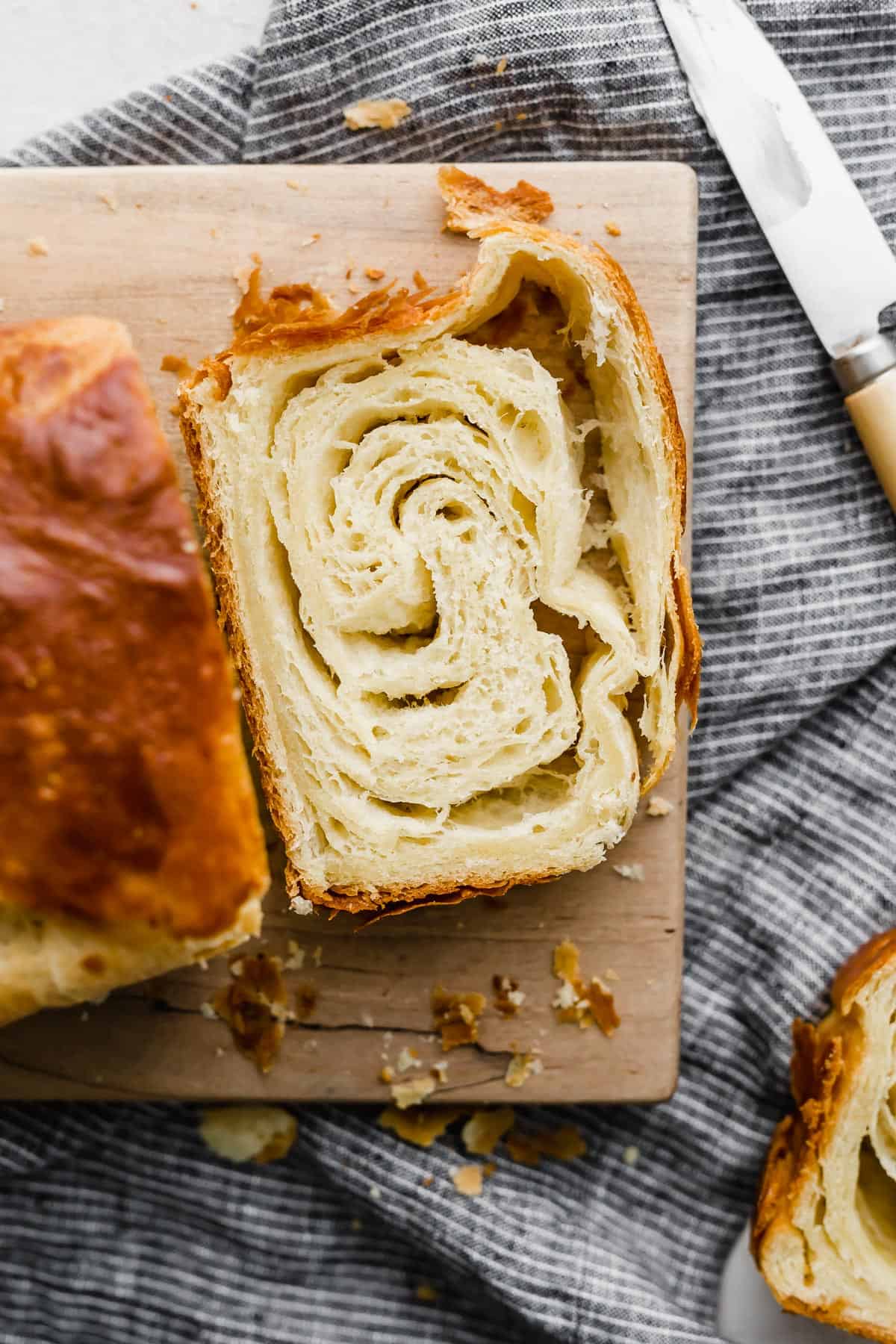
Why This Recipe Works
- Plenty of photos to walk you through the process. You will love this recipe because it is really easy to follow along with helpful photos to show how to do things and what your dough and lamination should look like along the way. This is really incremental in making this an easy process!
- Easy to follow step-by-step process. Bread lamination can be a bit intimidating, but I’ve illustrated the steps in detail and will walk you through the process. It will be simple and easy to follow along! Let’s get to it!
- Tons of delicious, flaky layers. This brioche bread recipe is super delicious and has tons of delicious, buttery, flaky layers. This is thanks to the lamination process! It’s a huge game changer and gives us that beautiful look and delicious texture.
- Yummy, butter flavor. This flaky bread recipe is super delicious and has a delicate texture and flavor. You will love it!
Ingredient Notes
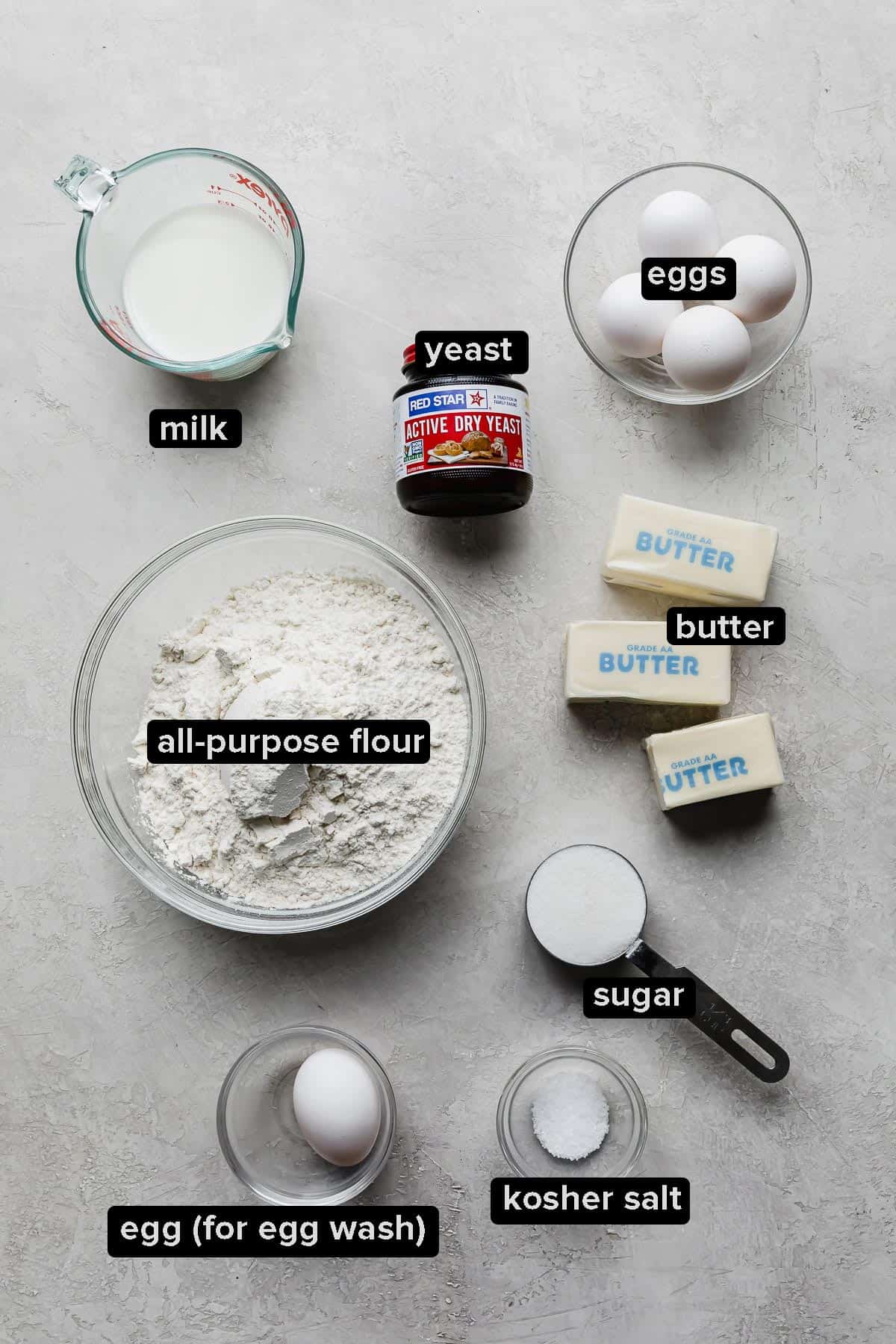
- Warm Milk: This will help activate the yeast.
- Yeast: Active or instant yeast is fine.
- Granulated Sugar: Since this flake bread is a sweet, the sugar is what provides that sweetness.
- Eggs: The dough is silky smooth thanks to the butter and eggs in the mixture — it’s what makes it that iconic pastry bread!
- Unsalted Butter: You need 6 tablespoons of the butter to be room temperature and 1 cup of unsalted butter to be slightly chilled.
- Egg: Use an extra egg for the egg wash! This is how we get that shiny, golden crust on the loaf.
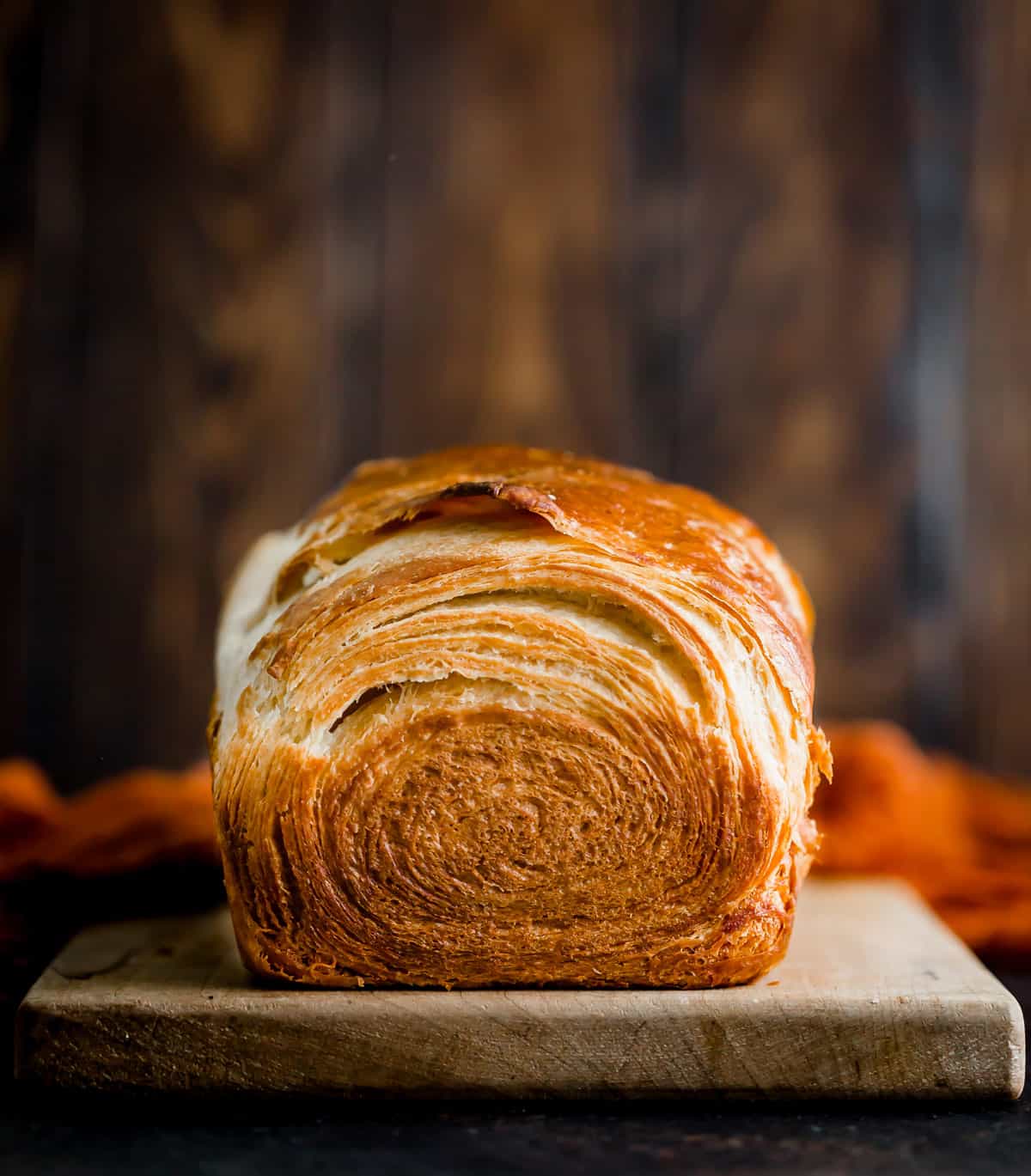
Step-by-Step Instructions
Make the dough
- Activate the yeast. In the bowl of a stand mixer, combine the active dry yeast and warm milk. Let this sit for 10 minutes or until foamy.
- Add flour, salt, and sugar. Once the mixture is foamy, add the flour, salt and sugar and combine using the dough hook. The dough will be really crumbly, not resembling a dough at this stage.
- Add the eggs. Next, add the eggs to the mixture and mix until the dough is smooth (about 6 minutes).
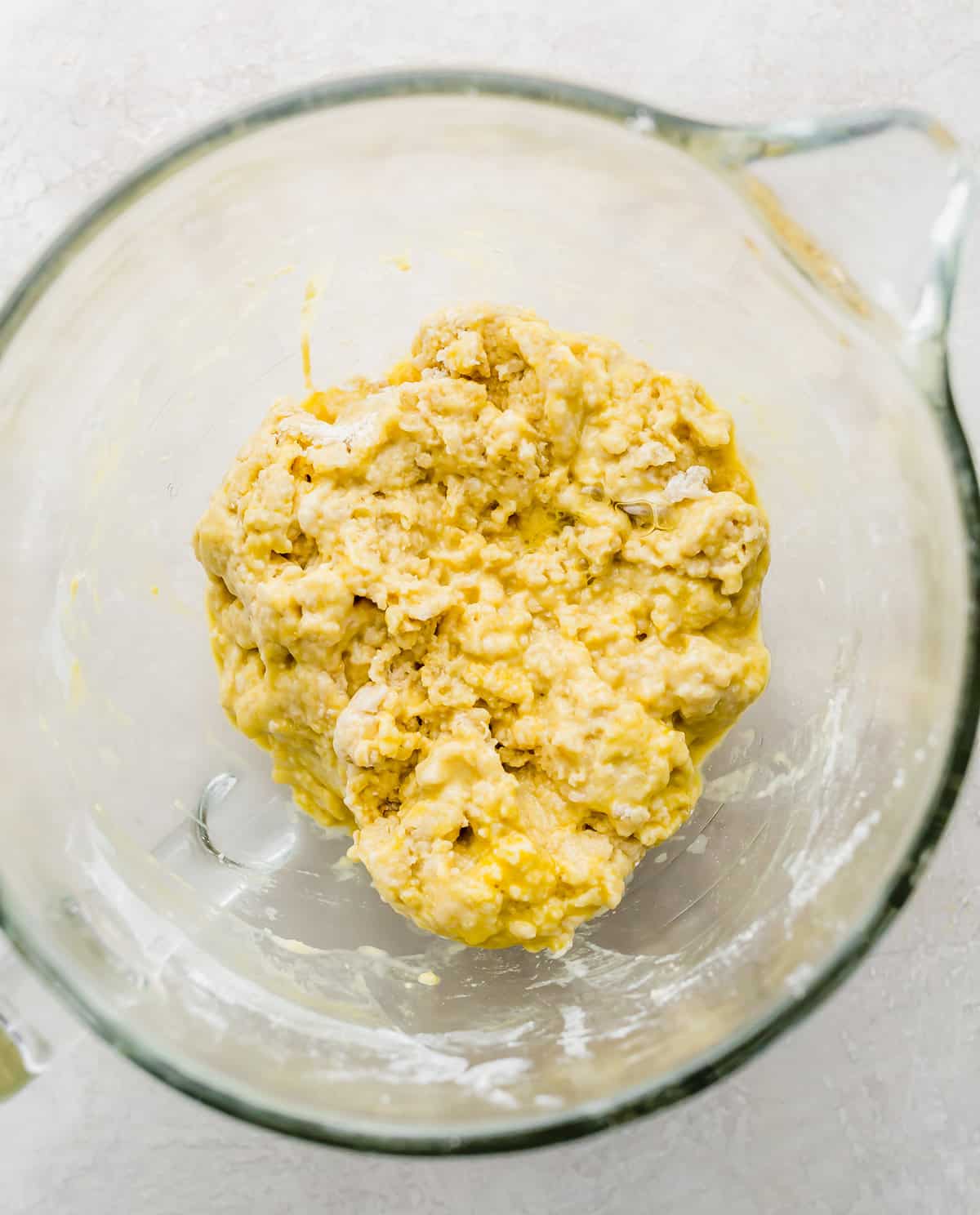
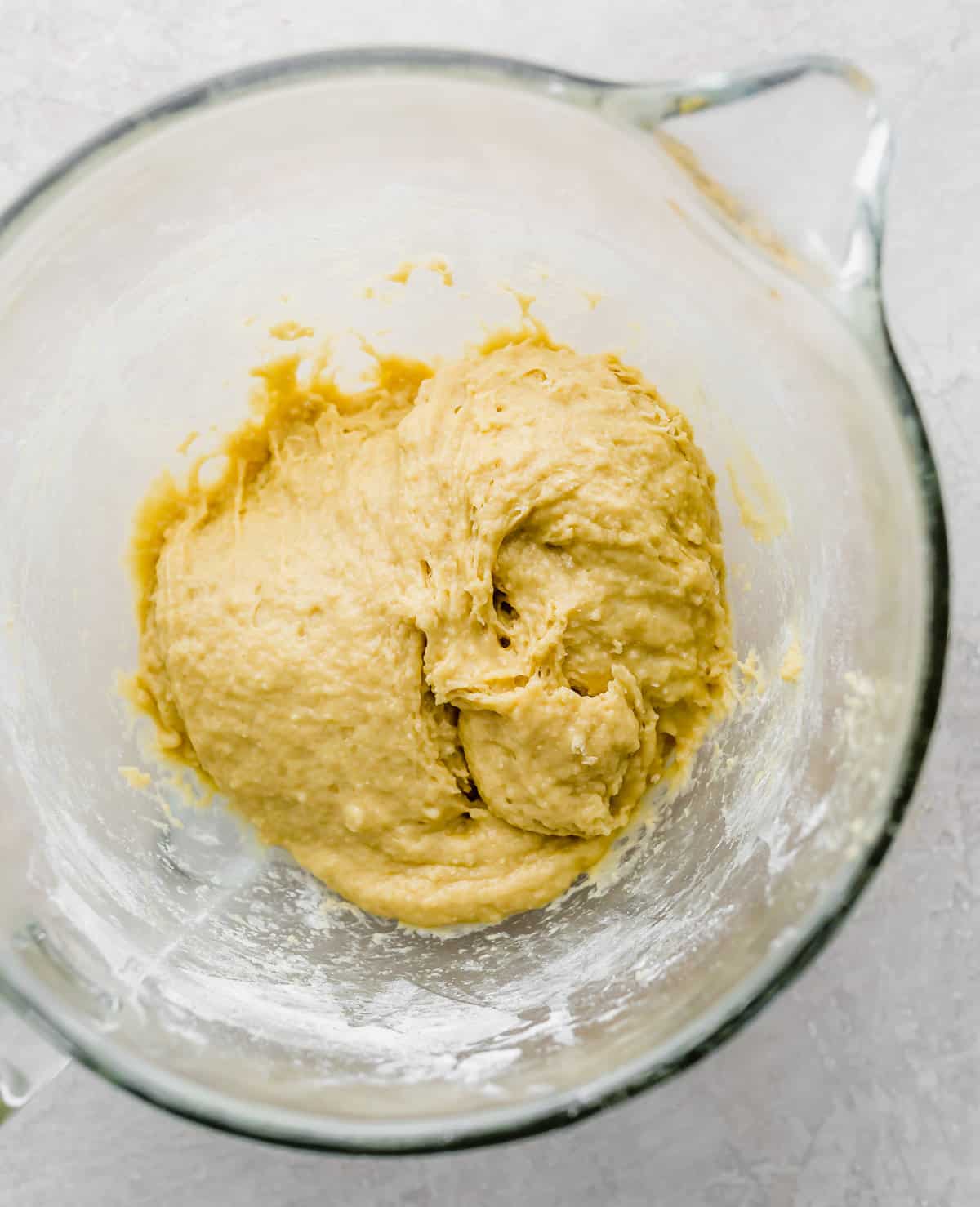
- Add the room temperature butter. Once the eggs are mixed in and the dough is smooth, add the room temperature butter 1 tablespoon at a time, mixing well after each addition. Continue mixing for 3 minutes or until the dough is smooth and shiny. If your dough is still really sticky at this stage, you can add 1 tablespoon of flour at a time and mix on low until your dough is the right stickiness. The dough should pull away from the sides of the bowl but the very tip of the dough should still stick to the bottom of the bowl. The dough will be smooth but not overly sticky. So you may need to add more flour depending on your dough’s consistency.
- Knead into a ball, wrap, and refrigerate. Turn the dough out onto a lightly floured work surface and knead the dough into a ball. Wrap it in plastic wrap and refrigerate the dough for 1 hour.
Prepare the butter for the lamination process
- Prepare the butter. While the dough is chilling, let’s prepare the butter for the lamination process. In the bowl of a stand mixer fitted with the paddle attachment, beat the slightly chilled butter until it’s broken up but smooth, about 1-2 minutes.
- Shape the butter. Place a sheet of parchment paper on a work surface. Scoop the butter onto the parchment and shape the butter into a 5×8-inch rectangle. Fold up the sides of the parchment to cover the butter. Refrigerate until the butter is chilled, about 20 minutes.
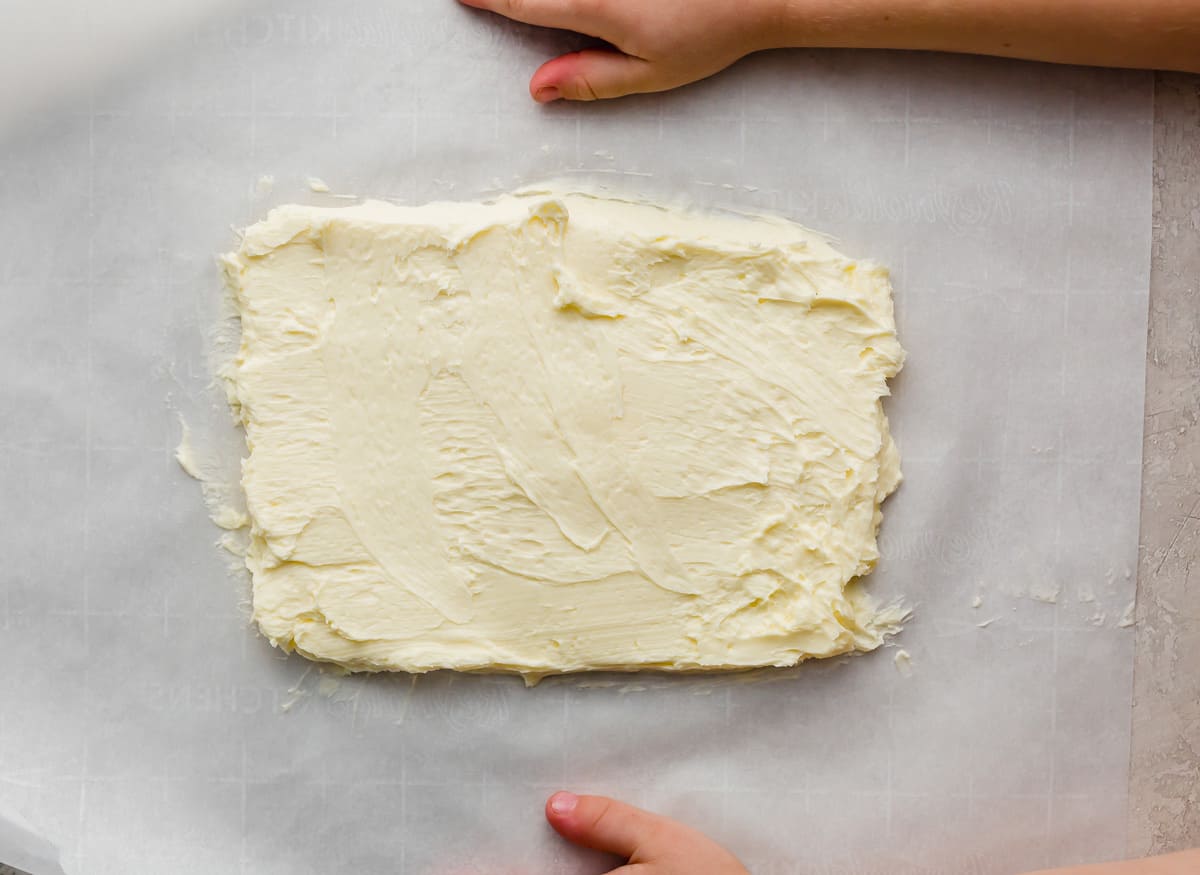
Brioche bread lamination process
- Shape the dough. Remove the dough from the fridge. On a lightly floured work surface, roll the dough out to a 7×18-inch rectangle. Place the chilled butter on the bottom half of the dough leaving a 1-inch border on 3 of the 4 sides.
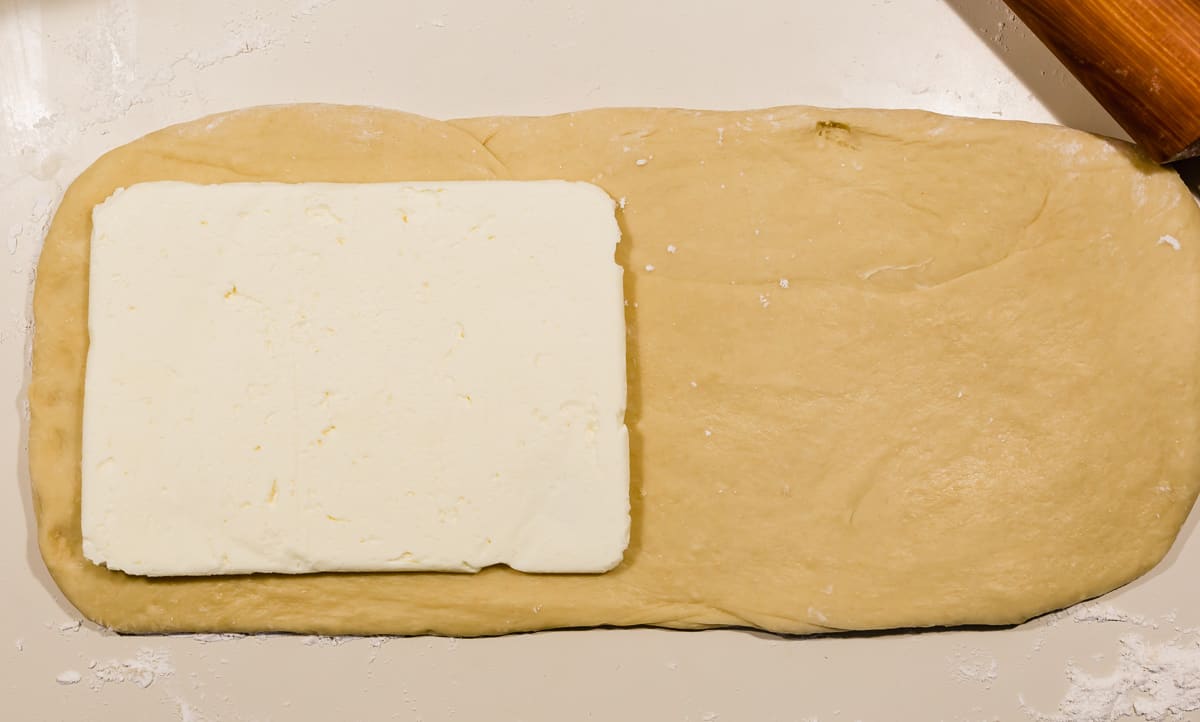
- Fold the dough. Fold the dough over to cover the butter, then pinch the edges to seal. Tuck the overhanging dough edges under to form a neat looking tucked package.
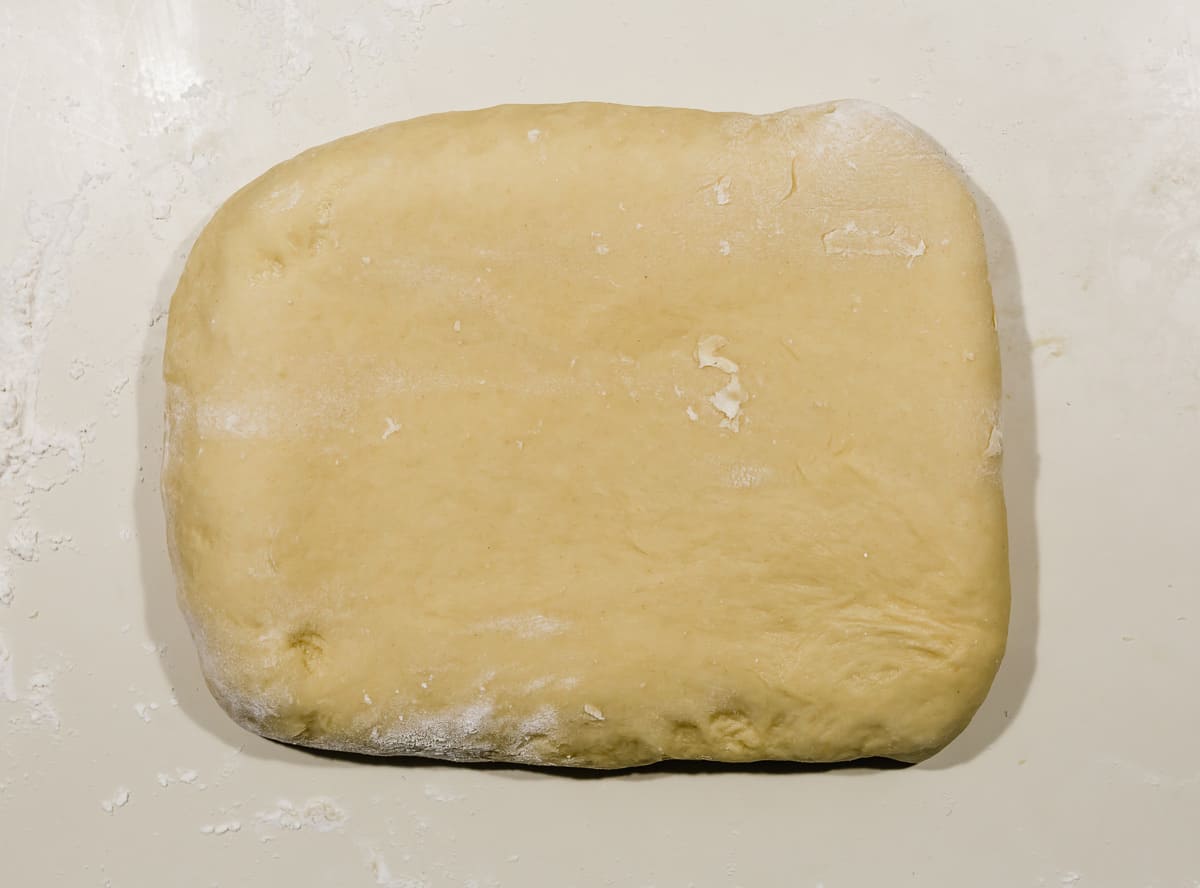
- Roll then fold the dough down. Roll the dough into a 7×18-inch rectangle. Fold the top third of the dough down towards the center.
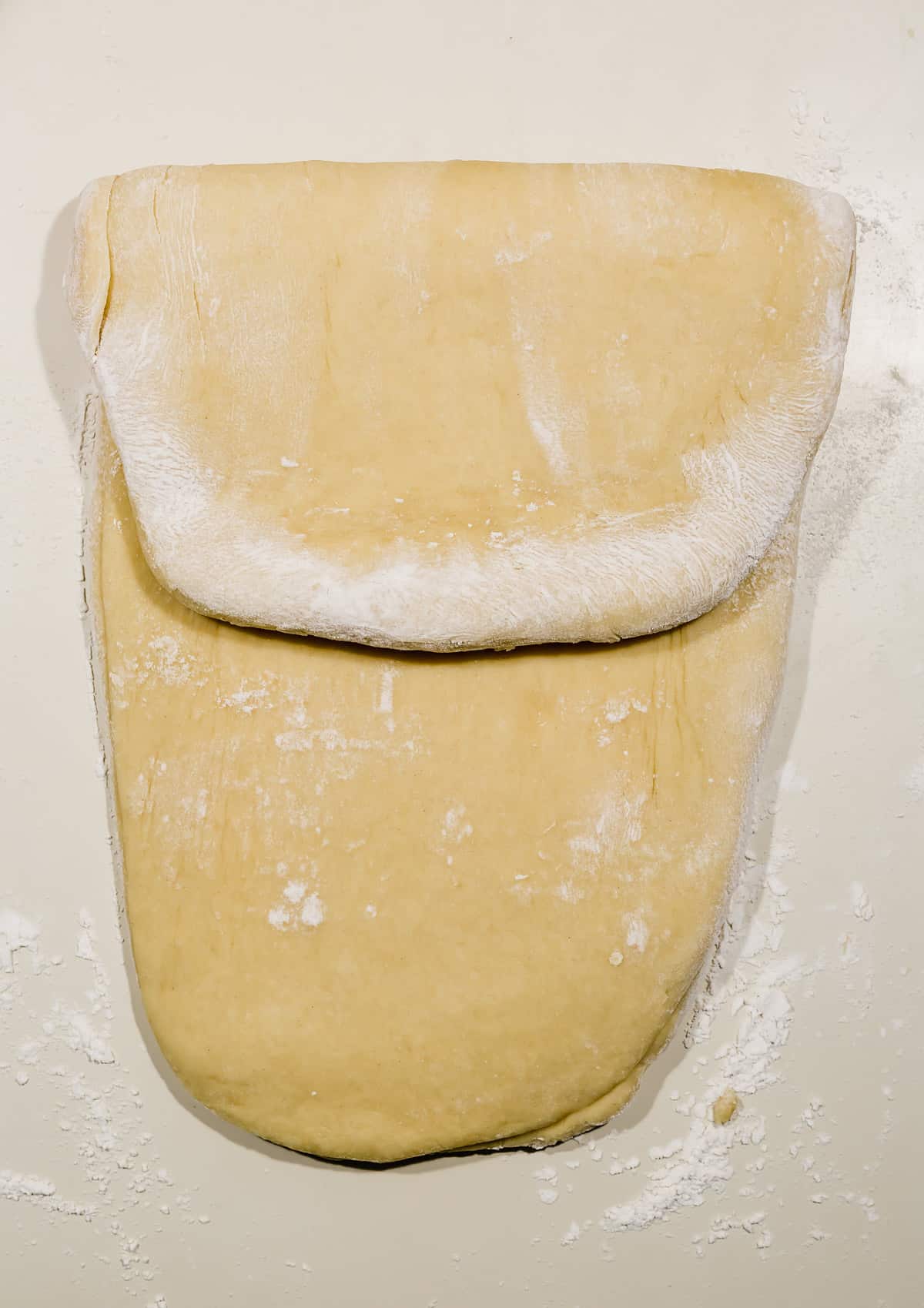
- Fold the dough up. Then fold the bottom third on top, Like a business letter. This completes 1 turn.
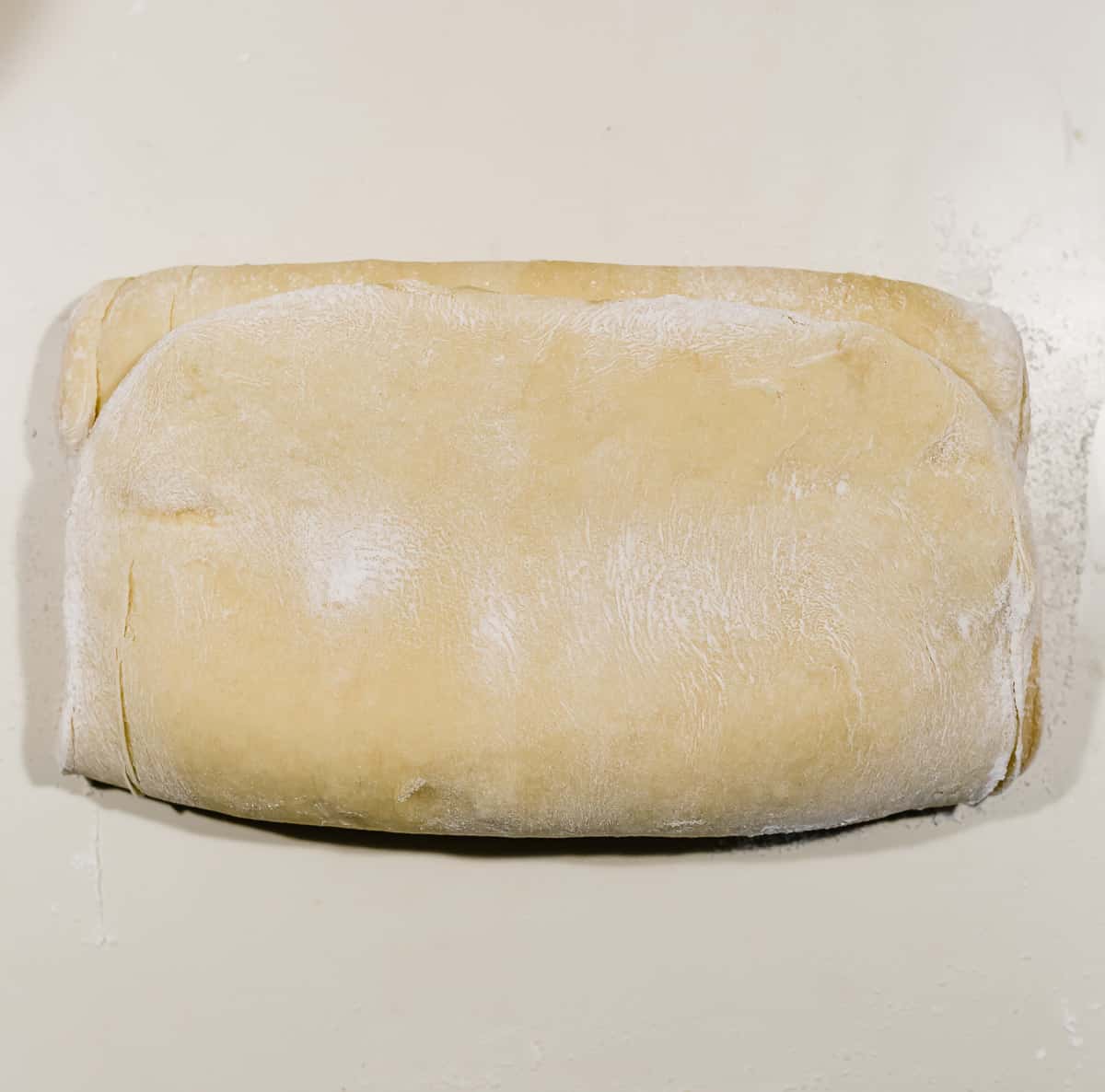
- Rotate and roll. Rotate the dough package 90°. Roll the dough into a 7×18-inch rectangle.
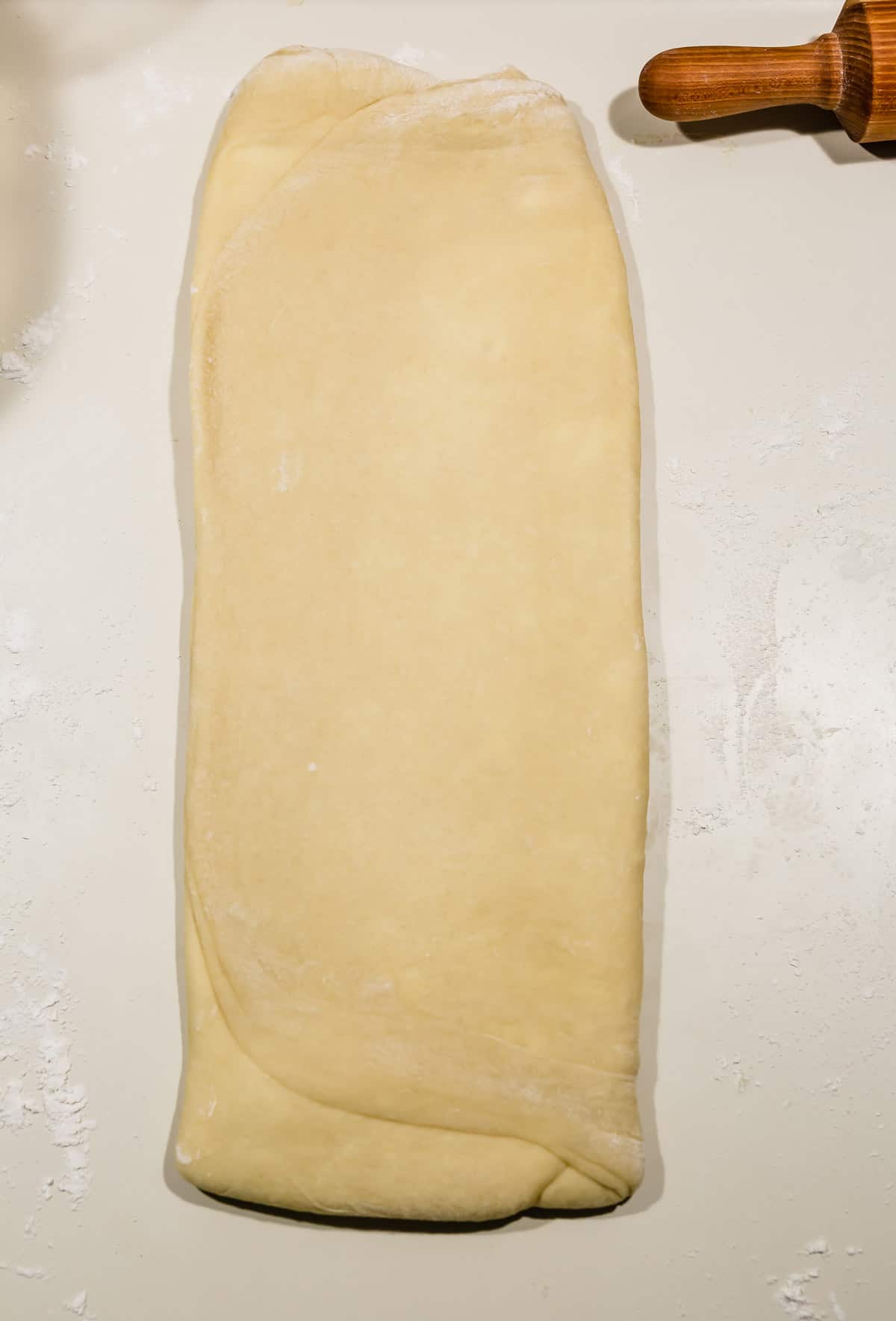
- Fold the dough down. Fold the top third of the dough down towards the center.
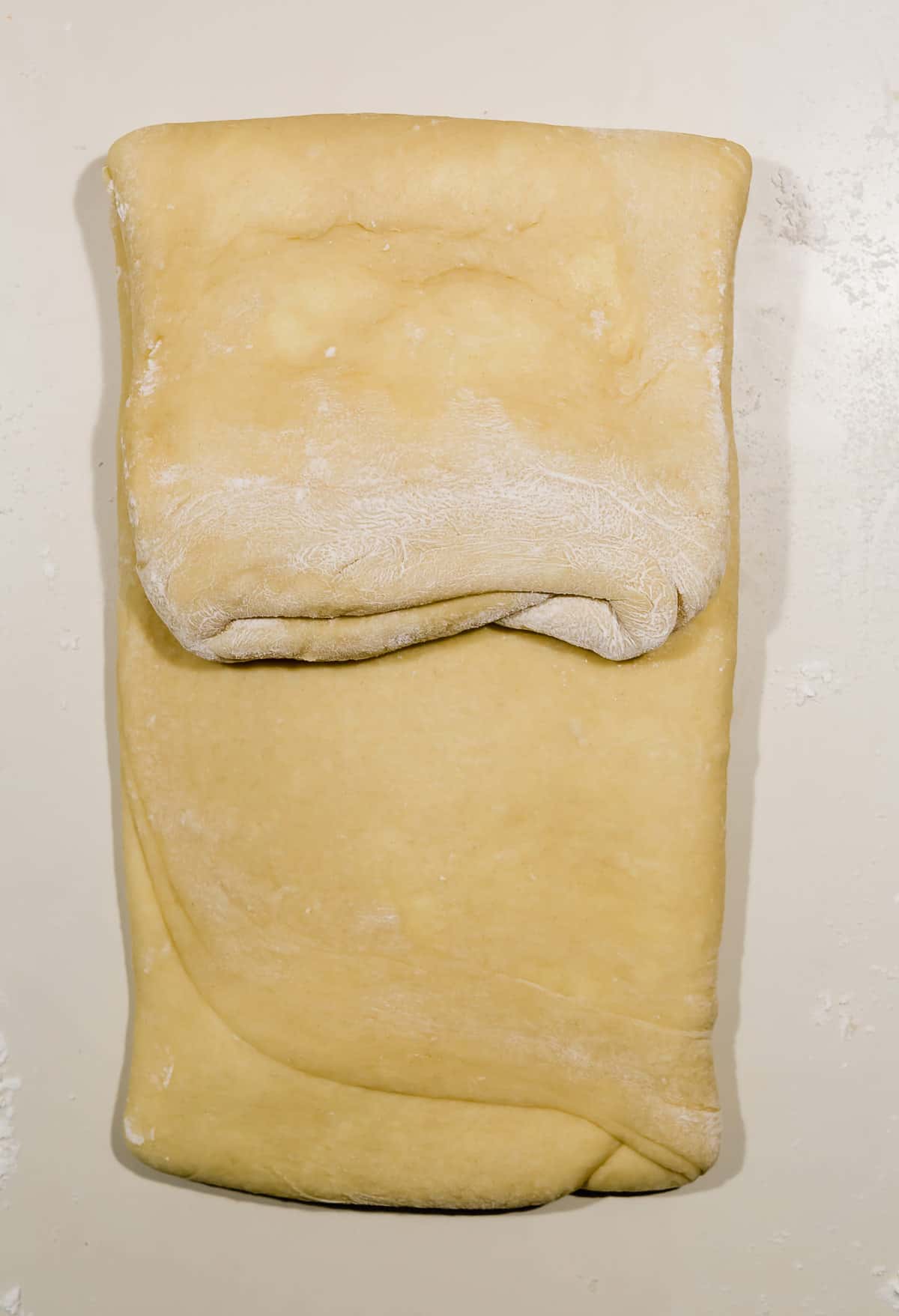
- Fold the dough up. Then fold the bottom third on top, like a business letter.
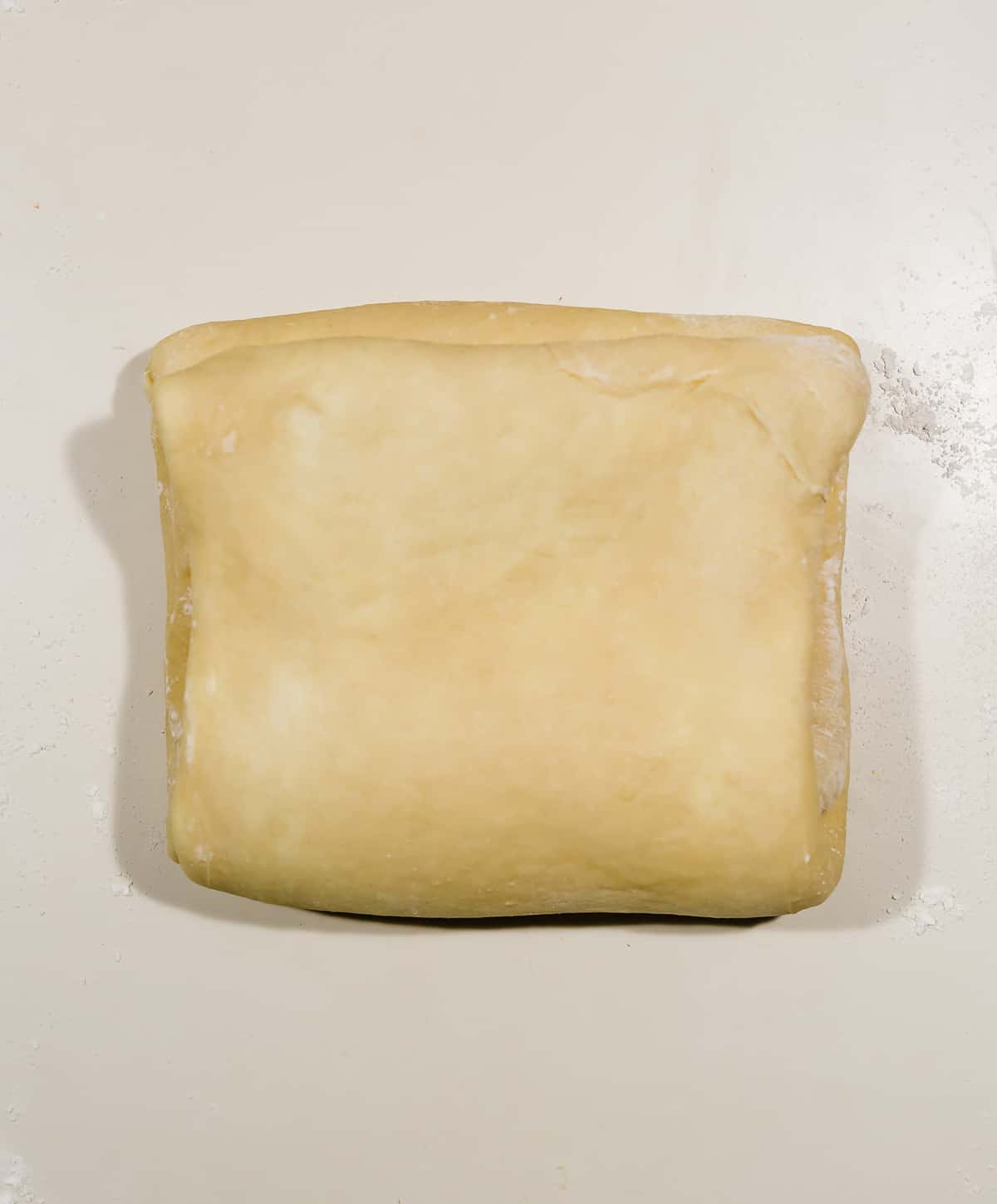
- Wrap and chill. Wrap the dough envelope in plastic wrap and refrigerate for 20-25 minutes or freeze for 12-15 minutes.
- Roll and fold again. Remove the dough from the fridge or freezer. Roll the dough into a 7×18-inch rectangle. Fold the top third of the dough down towards the center, then fold the bottom third on top, like a business letter.
- Rotate and fold again. Rotate the dough package 90°. Roll the dough into a 7×18-inch rectangle. Fold the top third of the dough down towards the center, then fold the bottom third on top, like a business letter. Wrap the dough envelope in plastic wrap and refrigerate for at least 1 hour or up to overnight.
Baking brioche bread
- Prepare the pans. When ready to bake, brush two standard 9×5-inch loaf pans with butter.
- Prepare for baking. Remove the chilled dough from the fridge and roll out the dough into a 12×18-inch rectangle. Roll the dough (like a cinnamon roll) into a log, trying to keep it tight as you go.
- Cut and place in pans. This brioche recipe makes 2 loaves. Cut the dough log in half so that you have two 9-inch logs in length. Place the dough logs seam side down in the prepared pans. Cover and let rise for 45 minutes to 1 hour or until about double in size.
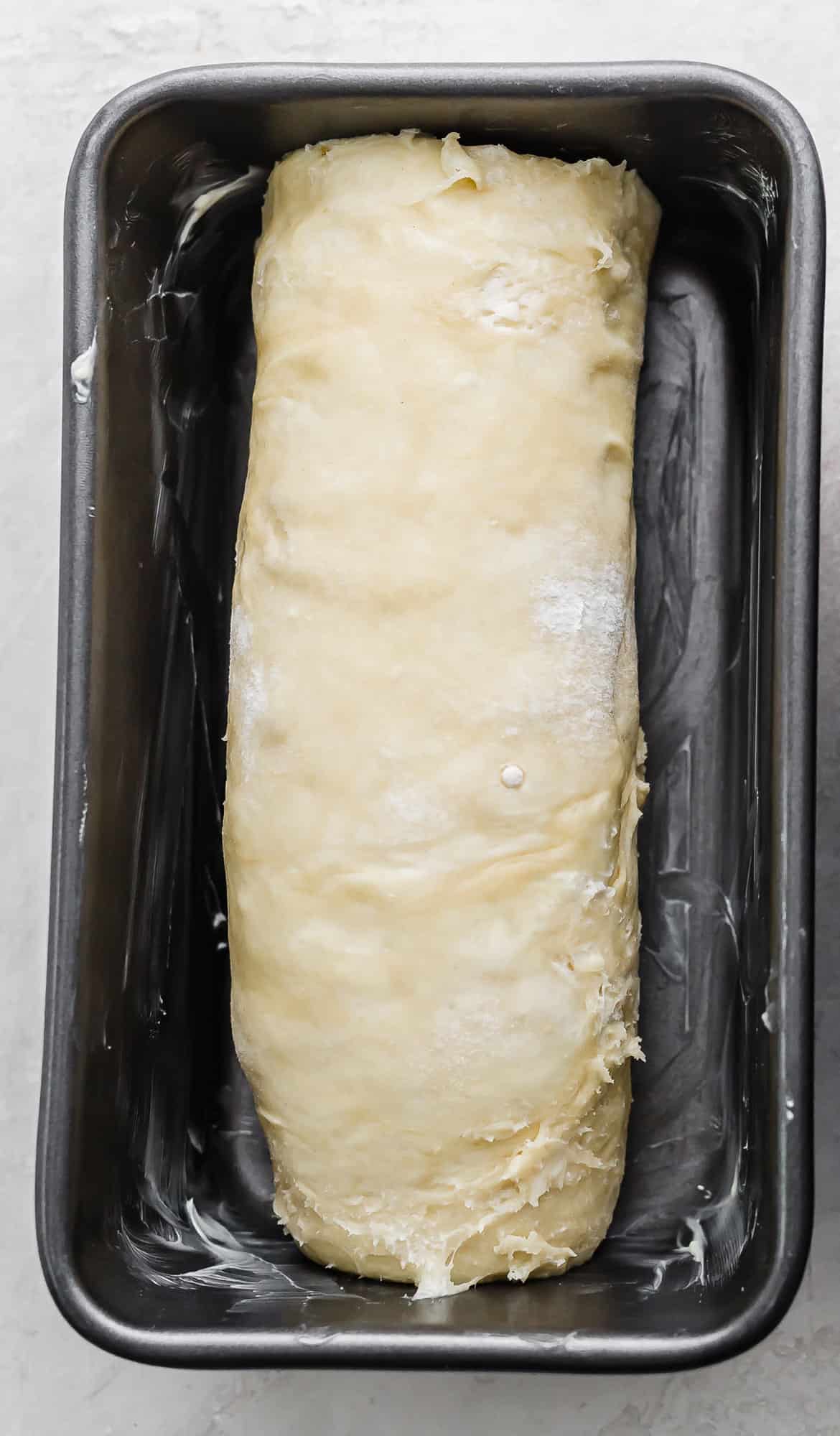
- Preheat the oven and prepare the egg wash. When ready to bake, preheat the oven to 350°F. Whisk 1 egg in a small bowl and brush the egg over the tops of the bread loaves right before placing them in the oven.
- Bake the loaves. Bake for 35-37 minutes or until the loaves are golden brown. Remove from the oven and let the loaves cool in the pans for 5-10 minutes, then turn them out onto a wire rack to continue cooling. Serve the flaky brioche warm or cold.
Recipe Tips
You can use active or instant yeast in this recipe. They are interchangeable. If you use instant yeast, you don’t have to wait the 10 minutes, but I still do. Maybe I wait out of habit? Either way, choose the yeast you want and use it 🙂
When adding the eggs in, the dough will appear quite dry and crumbly, but don’t worry because with time it really comes together and evens out.
Follow along with the step-by-step instructions and the photos above to see what the lamination process looks like. I really wanted to show you what the process looks like with the photos so you could get the process down. Making homemade brioche bread doesn’t have to be hard! It’s really fun and exciting to see how beautiful it looks when it comes out of the oven!
Nutritional information is based on 1 serving; you’ll notice there are 2 loaves in the “servings” area. If you want to know the nutritional info per slice, you’ll have to do some math.
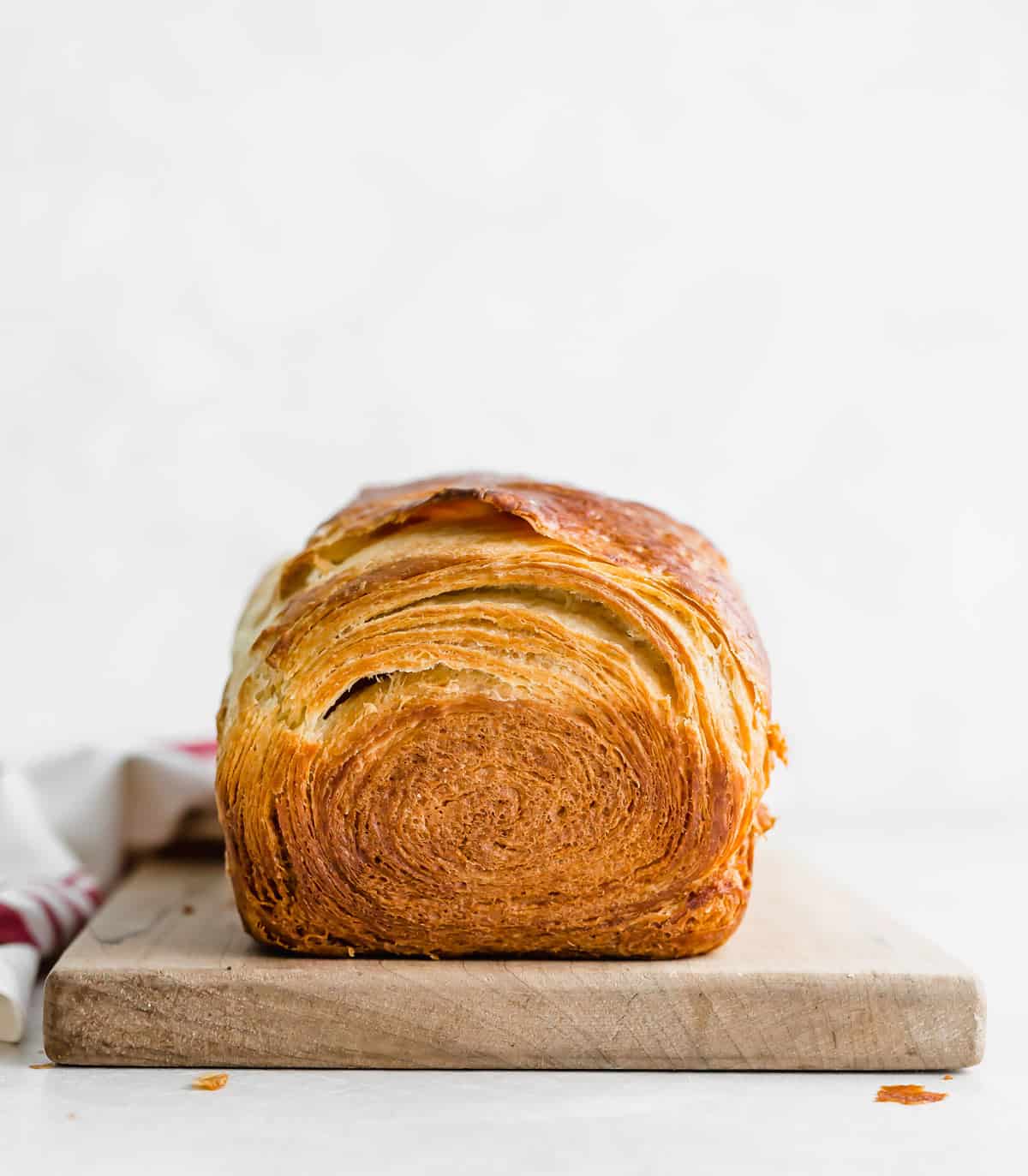
Make Ahead, Storing, and Freezing
Store the loaves in an airtight container or Ziplock bag (to stay soft) at room temperature for 3-4 days or in the fridge for up to 7 days.
To freeze the baked loaves, let them cool completely then wrap the loaves in plastic wrap and store in a Ziplock bag. The loaves should keep in the freezer for 1-2 months. Remove from the freezer and let thaw overnight in the fridge.
I haven’t frozen brioche dough before (I tend to just bake it right away so I can enjoyed it sooner!) But, according to my research, you can freeze it by wrapping it in plastic wrap after the first rise and storing it in an airtight container or Ziplock bag (try to remove as much air as possible from the bag or container). It should keep in the freezer for up to 2 weeks. Remove from the freezer and let thaw in the fridge overnight, then remove from the fridge, unwrap and let rise as the instructions direct, then bake.
FAQs
Brioche is a French bread that’s made using a high amount of fat (butter) and eggs. The high use of butter in the dough gives it a really rich flavor and turns the bread a deep golden brown when baking. It is light, fluffy, buttery and a bit sweet.
I haven’t tried freezing the dough before. But, if you want to freeze it, I recommend freezing the loaf after the first rise, then removing it and letting it come to room temperature and rise before baking. Be sure to tightly wrap the dough in plastic wrap and store in a plastic bag in the freezer.
Yes you can! Laminate the dough with the butter and then sprinkle the cinnamon sugar mixture on top of the butter before folding.
I haven’t make this substitution with this recipe, so I can’t say for sure if it would work out or not. Sorry! If you do switch it out, reach out and let me know how it went.
Because the lamination process is pretty thorough and particular, I wouldn’t recommend adapting this recipe to make into rolls. If making into rolls, you would need to laminate the dough as independent rolls instead of simply cutting the loaf into roll-sized dough after the lamination process.
Because the dough is pretty sticky during the mixing process, I would highly recommend using a stand mixer. Using something like a stand mixer or a bread mixer (like a Bosch) is better because their motors are much more robust to handle all the mixing/kneading of the dough.
For this recipe, we will be laminating the dough. This means we’ll be folding butter into the dough and layering it several times. This layering of the butter and dough will create lots of small layers so when the dough is baked it will result in a lot of airy, flaky layers.

Related Recipes
Did you make this recipe? I’d love to hear about it! Click here to leave a rating and review, or scroll below the recipe card and do so there.
Stay up-to-date by following us on Instagram, Facebook, and Pinterest.
Flaky Brioche Recipe
Ingredients
- 2/3 cup warm milk
- 2 1/4 teaspoon yeast - active or instant
- 1/3 cup granulated sugar
- 4 eggs
- 3 3/4 – 4 cups all purpose flour
- 1 teaspoon kosher salt
- 6 tablespoons unsalted butter - at room temperature
- 1 cup unsalted butter - slightly chilled
- 1 egg - for the egg wash
Equipment
Instructions
Make the Dough
- In the bowl of a stand mixer combine the yeast and warm milk. Let sit for 10 minutes until yeast is foamy and activated. Add in the flour, salt, and sugar. With the dough hook, stir to combine. Add in 4 eggs*, and mix until dough is smooth about 6 minutes.
- Add the room temperature butter, 1 tablespoon at a time, mixing well after each addition. Continue mixing for 3 minutes, or until the dough is smooth and shiny. If your dough is still really sticky add 1 T of flour at a time. The dough should pull away from the sides of the mixing bowl, and the very bottom of the dough will still be stuck to the bottom of the bowl.
- Turn the dough out onto a lightly floured work surface. Knead the dough into a ball. Wrap it in plastic wrap and refrigerate the dough for 1 hour.
Prepare the butter and layering
- In the bowl of your stand mixer fitted with the paddle attachment, beat the cold butter until it’s broken up but smooth, about 1-2 minutes.
- Place a piece of parchment paper on a work surface. Scoop the butter onto the parchment and shape the butter into a 5×8 inch rectangle. Refrigerate until the butter is chilled about 20 minutes.
- On a lightly floured work surface roll the dough out to a 7×18 inch rectangle. Place the chilled butter on the bottom half of the dough leaving a 1 inch border on 3 of the 4 sides. Fold the top half of the dough over the butter to cover, then pinch the edges to seal. Tuck the overhanging dough edges under to form a neat looking tucked package.
- Roll the dough into a 7 x 18 inch rectangle. Fold the top third of the dough down towards the center, then fold the bottom third on top, like a business letter. This completes 1 turn.
- Rotate the dough package 90 degrees. Roll the dough into a 7 x 18 inch rectangle. Rold the top third of dough down towards the center, then fold the bottom third on top, like a business letter. Wrap the dough envelope in plastic wrap and refrigerate for 25 minutes or freeze for 12-15 minutes.
- Remove from fridge or freezer. Roll the dough into a 7 x 18 inch rectangle. Fold the top third of the dough down towards the center, then fold the bottom third on top, like a business letter.
- Rotate the dough package 90 degrees. Roll the dough into a 7 x 18 inch rectangle. fold the top third of dough down towards the center, then fold the bottom third on top, like a business letter. Wrap the dough envelope in plastic wrap and freeze for 12-15 minutes or refrigerate for at least 1 hour or up to overnight.
Bake the Brioche
- When ready to bake, brush two standard 9×5 inch loaf pans with butter.
- Remove the chilled dough and roll the dough into a 12 x 18 inch rectangle. Roll the dough into a log, trying to keep it tight as you go. When you reach the edge, pinch the edges to seal.
- Cut the dough log in half (so that you have 2, 9 inch logs in length) and place seam side down in prepared pans. Cover and let rise for 45 minutes to 1 hour.
- When ready to bake, preheat oven to 350°F. Whisk 1 egg in a small bowl. Brush the egg over the tops of the bread loaves.
- Bake until loaves are lightly golden, about 35-37 minutes. Let the loaves cool in the pans for 5 minutes and then turn them out onto a wire rack to continue cooling.
- Serve warm or cold.
Notes
This recipe was originally published on Dec. 19, 2019. It was republished on Feb. 22, 2022, to include additional information and photos.

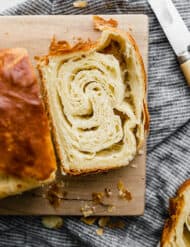
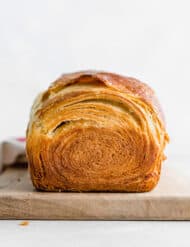
 Welcome to this delicious corner of the internet! Here I share the recipes my family loves.
Welcome to this delicious corner of the internet! Here I share the recipes my family loves.

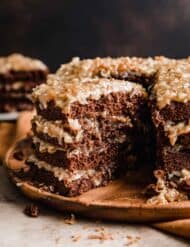

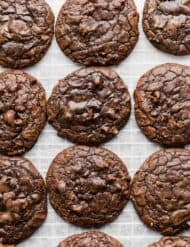

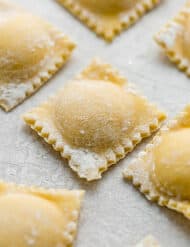
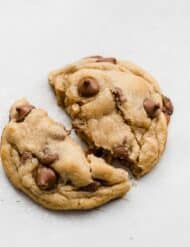




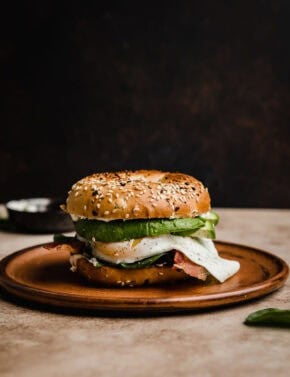


12 Comments on “Flaky Brioche Recipe”
yummy and thank you, have never made brioche, or much bread in general for that matter, but am enticed to try it since I love eating it, thank you!
Hi! Do you think this could work as hamburger buns? I want something flaky and soft. Thanks 🙂
I don’t know how they would turn out as hamburger buns. Sorry!
Will this be doable if I can replace active dry yeast with sourdough starter?
I’m not as familiar with sourdough starter, but I would say go-ahead and give it a try!
Hi! is it alright if I store one of the loaves in the freezer then bake it when I would like to eat it?
I haven’t tried freezing the loaves before. But if I were to go about it, I would freeze the loaf then remove it and let it come to room temperature and rise before baking. Hope this helps!
Thanks for all the photos! I can’t wait to give it a go. Do you think I could make the butter a cinnamon/sugar butter and laminate with it to make a cinnamon sugar loaf?
Yes you can! Do just as you said: laminate the dough with the butter and sprinkle the cinnamon sugar over the butter when laminating.
Awesome, thank you!
Hi Whitney! I love your blog and just wanted to tell you this recipe was so good! I was intimidated to make brioche for the first time but I went for it and your recipe made it SO doable! It turned out delicious and I couldn’t help bragging about how good my loaves looked. I wish I could include a picture of them in this comment! Thank you for taking the time to develop such a delicious recipe!
Thanks for the kind comment Kelly! Also I wish you could attach pictures in the comments, I would love to see your brioche loaf! Next time, you can always send me a DM on Instagram with the pic if you’d like! 🙂
Have a great day!